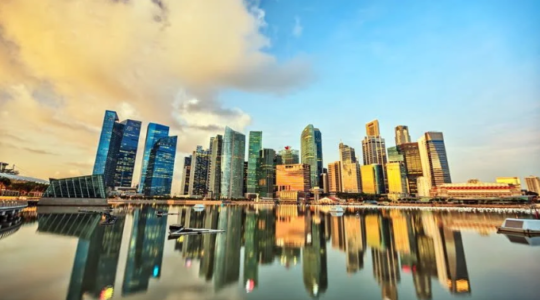Experts warn of potential economic slowdown amid external pressures and rising prices.
SINGAPORE: Singapore’s economy is facing turbulent times as the ongoing Russia-Ukraine conflict and stringent COVID-19 lockdowns in China exacerbate supply chain issues and drive prices higher.
“The road ahead remains bumpy,” cautioned OCBC’s chief economist, Selena Ling.
The economy recorded a slower growth rate in the first quarter of the year, with Gross Domestic Product (GDP) increasing by 3.7 percent year-on-year, as reported by the Ministry of Trade and Industry (MTI) on Wednesday (May 25). Although this figure surpasses the government’s preliminary estimate of 3.4 percent, it marks a decline from the 6.1 percent growth seen in the previous quarter.
Quarter-on-quarter, seasonally adjusted growth also tells a similar story, with the economy expanding by only 0.7 percent in the first quarter, down from a 2.3 percent increase in the preceding quarter.
While MTI has maintained its full-year economic growth forecast at 3 to 5 percent, it has warned that growth is likely to lean toward the lower end of this range due to a deteriorating external economic climate.
Emerging Headwinds A significant concern is the potential economic slowdown in China, which MTI indicated could directly affect some of Singapore’s export-oriented sectors, particularly the chemicals cluster.
Manufacturing, which represents about one-fifth of Singapore’s economy and has been a key driver of recovery, is also expected to face challenges, noted DBS senior economist Irvin Seah.
“Domestic demand in China has weakened amid rising COVID-19 infections and lockdowns in major cities, leading to significant disruptions in regional supply chains,” he explained. “This will have serious implications for Singapore’s manufacturing sector.”
Manufacturing has already shown signs of decline, as the sector contracted slightly in the first quarter, marking its first decrease in a year. Other risks contributing to economic uncertainty include the ongoing war in Ukraine, which has driven up prices across various sectors, including energy and food, and the potential for slower global growth as major central banks tighten policies to combat inflation.
These global challenges are expected to hinder Singapore’s recovery and undermine growth in the latter half of the year, according to Maybank economists Chua Hak Bin and Lee Ju Ye.
Inflation, which has surged to decade-high levels, is anticipated to remain elevated due to rising commodity prices, persistent supply chain disruptions, and a tight labor market. A recent development, such as Malaysia’s ban on chicken exports effective June 1, will further amplify inflationary pressures, said Mr. Seah.
Food items account for roughly one-fifth of Singapore’s consumer price index, with meat, including poultry, comprising only about 1 percent. However, prices for other food components, such as eggs and cooking oil, have already risen.
High inflation could dampen consumer spending, as individuals begin to feel the financial strain. JPMorgan’s economic analyst Ong Sin Beng warned that continued increases in core inflation may exert pressure on real incomes, posing a risk to what would otherwise be a positive outlook for domestic recovery.
A Silver Lining? Despite these concerns, some analysts believe that the outlook may not be entirely bleak. Barclays economist Brian Tan described MTI’s forecast for growth at the lower end of its range as “very conservative.” He retains a full-year growth projection of 4.9 percent for Singapore, citing the relaxation of local restrictions in the second quarter and the anticipated influx of tourists.
“The impact of these changes will be substantial,” he noted, asserting that the growth outlook for 2022 “should still be fairly solid.”
Capital Economics economist Alex Holmes also anticipates that Singapore’s full economic reopening will likely bolster performance in the second quarter. “Even if the economy experiences below-trend growth in the latter half, an annual growth rate of 4 percent remains achievable,” he asserted.
Despite the slower growth figures, experts emphasize that the economy is diversifying beyond just manufacturing. HSBC economist Yun Liu highlighted that the services sector emerged as the “largest contributor to headline growth” in the first quarter, reflecting a recovery in travel-related sectors.
The construction sector also saw upward revisions in growth for the first quarter, indicating strong activity in March as domestic restrictions were eased and labor shortages began to resolve.
Tackling Inflation As inflationary pressures mount, observers expect the Monetary Authority of Singapore (MAS) to continue its policy tightening approach. The central bank has already enacted three rounds of monetary policy tightening since last October, including an unexpected inter-meeting adjustment aimed at strengthening the Singapore dollar.
Further measures during the next policy review in October may include an additional increase in the slope of the policy band, although some experts anticipate the possibility of an earlier off-cycle adjustment.
“With both headline and core inflation hovering near the upper limit of MAS’s projections, the central bank may need to implement another off-cycle move before its biannual meeting in October,” noted Moody’s Analytics.
The MAS projects core inflation, which excludes accommodation and private transport costs, to range between 2.5 and 3.5 percent for the year, while headline inflation is expected to average between 4.5 and 5.5 percent.
In April, core inflation surged to 3.3 percent, the highest level recorded since early 2012, while headline inflation remained steady at 5.4 percent.
Beyond a hawkish monetary policy, economists suggest that fiscal measures could also be on the table. Targeted fiscal assistance may be provided to help both businesses and households cope with rising costs, according to OCBC’s Ms. Ling.
Additionally, Liu remarked that Singapore possesses “one of the strongest fiscal positions in Asia,” enabling it to offer short-term and targeted relief measures for households, potentially in the form of consumption vouchers and utility subsidies.
While some temporary fiscal support may be feasible, Mr. Seah from DBS cautioned that the government is unlikely to introduce a supplementary budget, given that the economy is “not in a recession scenario.”








